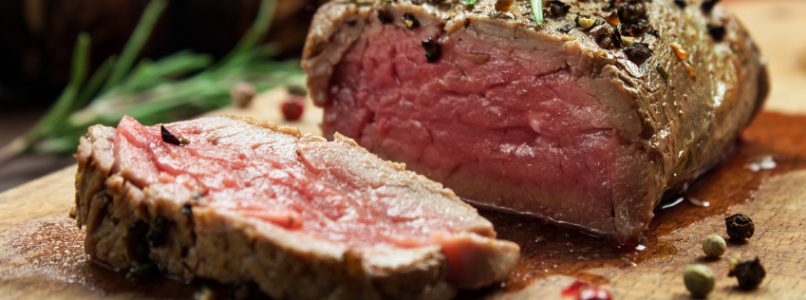A unique and precious cut of meat, not to be spoiled with the wrong cooking! From cutting to cooking, here's how to cook fillet
Fillet: this word defines the absolutely most tender and prized cut of beef, so unique that, unlike what happens for all the other parts, it is called the same way in all regions of Italy. The fillet occupies the vault of the lumbosacral region of the animal. It runs parallel to the rib, under the lumbar vertebrae and near the kidneys. It has more or less the shape of a thin cone, whose base is in direct contact with the rump. It is a set of muscles subjected to very little effort and this explains why they give such a tender flesh. Unfortunately it has very small dimensions: it represents, in fact, just 2.5 percent of all the meat that can be obtained from a bovine and can weigh, at most, around four kilos. Once the fat that covers it and the waste parts has been cleaned, the useful portion reaches, more or less, the weight of three kilos. This explains the high cost of this delicious meat.
The cutting of the meat
The fillet, therefore, is a single piece but, given its elongated shape which is shrinking, it is usually divided into three parts: the head, that is the largest part, the heart, or the middle part, and the tail, the thinnest, which is located under the ribs. Of the three, the head is the least fine, being somewhat intersected by tendons and connective tissue; it can be used for steaks, or cleaned and finely chopped with a knife: it is used to prepare steak tartare or also, sliced, for a carpaccio. From the central part, the heart, of regular shape, you can get the Chateaubriand, large slices weighing about 400 grams each, which are cooked briefly, like steaks, for 2 people. From the tail, which becomes gradually thinner, it is possible to cut (as indeed from the heart) round-shaped slices, the tournedos, or even more tiny fillets called filets mignon (it takes two or three for a portion). Also from the third part you can cut slices for carpaccio and pieces to be minced by hand, with the knife, for tartare of raw meat.
The preparation
One of the reasons that make fillet a meat so requested and appreciated is that the preparations that use it require a few minutes of cooking and very few elaborations and additions of herbs and flavors. Its cooking base, in fact, is almost always sufficient to complete the processing. The tenderloin is so tender and tasty that it can be eaten even raw or simply seared. The longer you cook it, the less tender and juicy it becomes
The pan
The important thing, however, is to remember that the first impact with the pan is crucial for the final result. The pan, in fact, preferably made of iron, must be very hot as well as the fat (butter or oil). At the time of browning, in fact, the crust is formed which prevents the moods from dispersing (the red meat contains little humidity), holding them inside to give the preparation juiciness and flavor. However, there is always a certain loss of humidity, so much so that the thickness of a well-cooked steak is less than that of the same still raw.
Cooking
A fillet steak weighing 150/200 g requires a cooking time ranging from 2 to 5 or 6 minutes per side (the French say 1 to 4 minutes), depending on whether you want it cooked or cooked. Of course, times increase if the piece is larger.
How to understand if the fillet is cooked to the right point?
There are various ways to find out where the meat has come to cooking: one of these, empirical, but still effective, is to prick it with a skewer: if it is still in the blood, a drop will come out, but as the cooking proceeds, the color of the liquid that comes out becomes more and more clear. It should be noted that this test must be done in moderation, so that the pricks do not let the meat juices come out
The temperature
Very bad (blue, rare): to cook a fillet steak (3 cm thick) you need 2 'per side. By pricking it with a skewer, dark red blood comes out. Temperature measured in the center, 45 ° C.
To the blood (saignant, medium-rare): to cook the same slice of fillet at this point, you need 3 ′ 30 ”per side; tip with a skewer, it emits bright red blood. Center temperature, 50 ° C.
Medium or half (au point, medium): this degree of cooking requires 4 ′ 30 ”per side. Pricking the center of the fillet with a skewer, a pink juice comes out. Center temperature, about 60 ° C.
Well done (bien cuit, well done): to reach this degree of cooking it takes 5 ′ 30 ”per side. By pricking the center of the slice, the juice that comes out is clear pink. The temperature in the center is around 70 ° C.
"Parare" and "harness" the fillet
Parrying, in culinary jargon, means cleaning the meat of skins, ligaments and fatty parts. The cord that runs along the piece must be removed from the fillet, cutting the skin that holds it together and then pulling it towards yourself with a sharp and sharp knife. Then also cut the remaining skin.
The tournedos, whose weight is around 150 g, are 2 to 3 cm high: because they cook on a regular basis, it is advisable to tie them with one or two rounds of white kitchen twine so that they do not widen or deform during cooking . Bardarlo (wrap them) with a few slices of lard or bacon is also used to hold the juices of the meat during cooking, which will thus remain even softer and tastier. The permanence of the meat on the grill or in a pan must be very short.

